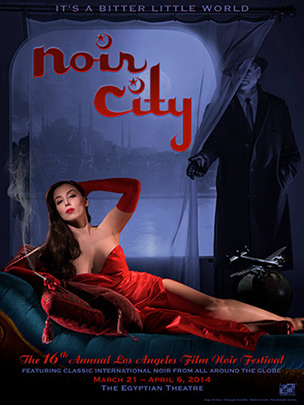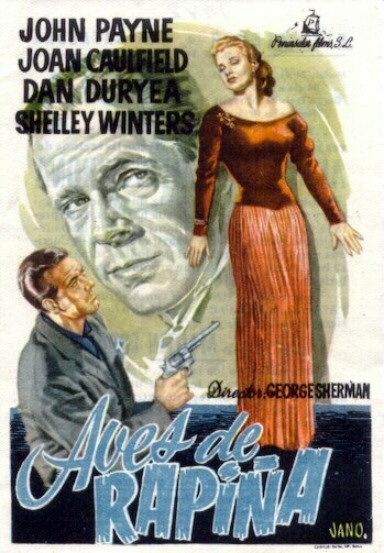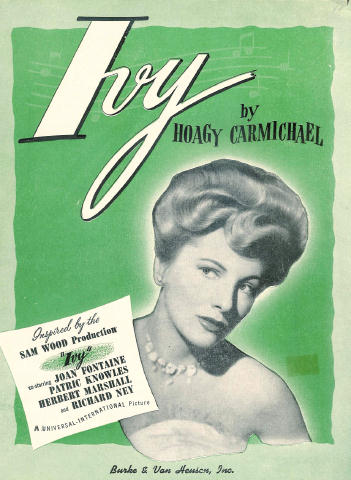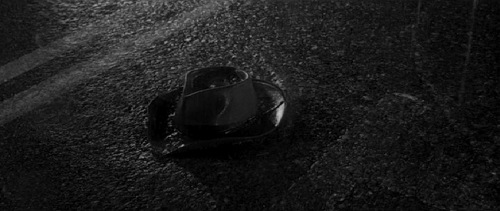
Los Angeles, California: the landscape for a criminally high number of films noir and the premiere setting for an unwieldy number of hardboiled novels and crime fiction. Of this urban environment, Aldous Huxley once remarked, “Thought is barred in this City of Dreadful Joy, and conversation is unknown.”
As a native Angelena, I quite like that my home has been labeled a “City of Dreadful Joy” and that any kind of exchange of words is somewhat mysterious. These elements (and other similarly toned descriptors) have always deeply connected me to crime fiction and its cinematic equivalent. Los Angeles has a long history with noir cinema. This film-based city and its highly urban-centered film genre/film cycle practically share genetic material. In other words, one thing would not be the same without the other.
Thusly, for a local such as me, it makes it even more exciting and appropriate when, once a year, Eddie Muller and the Film Noir Foundation bring NOIR CITY to the City of the Angels and spend some time with us at the American Cinémathèque!
I’ve been going to this festival for YEARS. Some of my dearest and greatest film memories were created here. It was here where I decided that I wanted to be a film archivist. NOIR CITY Los Angeles is the location where I have seen the vast majority of the films that knocked me out to the point of me chatting about them for the remainder of the year, until the next fest came along! My genuine joy with the quality of the prints, the acting and the stories just overflows every year. And it has been a social/film community thing, too- NOIR CITY allows me to spend a healthy amount of time in one of my favorite LA theaters, getting to see people that only come out for this festival. The Film Noir Foundation has provided quite a bit up until this point in this manner- for me and all my friends and colleagues.
I’m also in a unique position this year. As many of you may be aware, I was honored by the Film Noir Foundation in January with an award that really only happens in a noir fan’s (and recently graduated archivist’s), greatest dreams: I became the first participant in the Nancy Mysel Legacy Project, meaning that I will be working with the FNF on their next restoration project. I don’t think I have to tell you how thrilled I am. It’s all I’ve ever wanted and more.
This brings a new layer to attending this year’s NOIR CITY Los Angeles for me. It’s my home festival! For those of you in Los Angeles who may have not had the chance to go to NOIR CITY before, or may not have considered it, I would ask you to join me. Not just because it truly is one of the best film festivals, but also so that you may see what it is that I am completely and totally head-over-heels in love with, and have dedicated my life to preserving. These are incredibly special and wonderful pieces of cinema. I would love to spend some time with you experiencing these films and reveling in the dark. Shall we do so?
Last thing I will say before I go into the films themselves: since I have been to the festival quite a bit before- I have to say that this year in particular is pretty spectacular. GREAT 35mm prints, wonderful international work, exquisite restorations. And these are all things that I would say even if I were not involved somehow with the FNF. Seriously, the line-up is truly mind-blowing, and I am so excited! Hope to see you there! Oh and one last thing- I would highly suggest buying tickets for the shows ahead of time. They have been known to sell out. Your link to buy said tickets to get you into the marvelous dark mayhem of NOIR CITY can be found right here and if you want other info about the Egyptian theater itself (parking, etc), that may be found here.
NOW, AS THEY SAY, ON WITH THE SHOW!!!!
Friday – March 21, 7:30 pm
Introductions by Eddie Muller and Alan K. Rode of the Film Noir Foundation!

Too Late For Tears
TOO LATE FOR TEARS – 1949, 99 min, USA, Dir: Byron Haskin – 35mm
Restored by the Film Noir Foundation and UCLA Film & Television Archive, featuring Lizabeth Scott and Dan Duryea, this film is the film noir you didn’t know you were missing and the restoration you didn’t know could look this great! Unbelievably thrilling LA-footage and unforgettable characters!
LARCENY – 1948, Universal, 89 min, USA, Dir: George Sherman – 35mm
More Dan Duryea, and there’s nothing wrong with that! A rare one with Shelley Winters and the first film work of John Payne, the title may seem dishonest but the quality is straightforward good stuff!

Larceny
Saturday – March 22, 7:30pm
Introduction by Eddie Muller of the Film Noir Foundation

Born to Be Bad
BORN TO BE BAD – 1950, Warner Bros., 94 min, USA, Dir: Nicholas Ray – 35mm (print from the George Eastman House collection)
Two words: Nicholas Ray. Two more words: Joan Fontaine. If those things mixed with a healthy slap of Robert Ryan doesn’t throw ya, I couldn’t imagine what would. This one’s going to be a doozie!
IVY– 1947, Universal, 99 min, USA, Dir: Sam Wood- 35mm
The second in this “Joan Fontaine double feature,” this film is not available on DVD so this is definitely not to be missed. Additional factoid: the role that Fontaine plays in this was originally supposed to go to her sister Olivia de Havilland! Oops!

Ivy
Sunday – March 23, 7:30pm
Introduction by Eddie Muller of the Film Noir Foundation

Two Men In Manhattan
TWO MEN IN MANHATTAN (DEUX HOMMES DANS MANHATTAN) – 1959, Cohen Film, 84 min, France, Dir: Jean-Pierre Melville – DCP
Part of the monthly Cohen Film collection series, this Melville film is also part of NOIR CITY’s new focus this year on international noir works. This film is in French and English with English subtitles, and promises to be a real treasure!
RIFIFI – 1955, Rialto Pictures, 122 min, France, Dir: Jules Dassin – 35mm
A French heist picture directed by an American noir professional, this is globally considered to be one of the classics in crime cinema. French with English subtitles.

Rififi
Wednesday – March 26, 7:30pm

It Always Rains on Sunday
IT ALWAYS RAINS ON SUNDAY – 1947, Rialto, 92 min, UK, Dir: Robert Hamer – 35mm
Somewhere between kitchen sink drama and noir is this film. Googie Withers really brings it in this exciting British entry to NOIR CITY!
BRIGHTON ROCK – 1947, Rialto, 92 min, UK, Dir: John Boulting – 35mm
The baby-faced and ultra-young Richard Attenborough plays one of the most sinister and blood-curdling characters in all of film noir in this film: Pinkie. Every bit of this film is fulfilling in a way that is, once again, wholly British, reminding us of this year’s international theme.

Brighton Rock
Thursday – March 27, 7:30pm

Caged
CAGED – 1950, Warner Bros., 96 min, USA, Dir: John Cromwell – 35mm
If ever there was a film that depicted women in prison, CAGED is one of the most star-studded and powerful. The first entry in the Eleanor Parker double feature, this film also showcases Agnes Moorehead, Jan Sterling and many others. Will not disappoint!
DETECTIVE STORY – 1951, Paramount, 103 min, USA, Dir: William Wyler- DCP
Another great performance from Eleanor Parker, matched only by the presence of one, Kirk Douglas, and directed by William Wyler. This film was nominated for several awards. Come and see why!

Detective Story
Friday – March 28, 7:30pm
Introduced by Alan K. Rode of the Film Noir Foundation

Jenny LaMour
JENNY LAMOUR (QUAI DES ORFÈVRES) – 1947, Rialto Pictures, 102 min, France, Dir: Henri-Georges Clouzot- 35mm
A fantastic police procedural by the director of such gems as Diabolique and The Wages of Fear, this film is another look into how film noir was explored in the country of the term’s birth. In French with English subtitles.
ANGELS OVER BROADWAY – 1940, Sony Repertory, 79 min, USA, Dir: Ben Hecht, Lee Garmes- 35mm
This incomparable Ben Hecht-penned & directed film features Rita Hayworth & Douglas Fairbanks, Jr in a film about cons, gambling and moral devastation. You know- noir standards! Hecht was nominated for this screenplay- come and see why!

Angels Over Broadway
Saturday- March 29, panel at 6:30pm, film at 7:30pm
6:30pm – Southern CA Chapter of the Mystery Writers of America meet for a discussion on Los Angeles in noir and literature. Featured panelists: novelists Eric Beetner (Dig Two Graves), P.G. Sturges (the Shortcut Man series), and Steph Cha (Follow Her Home). Book signing will occur in lobby, shortly after the panel.
Introduced by Alan K. Rode of the Film Noir Foundation

Southside 1-1000
SOUTHSIDE 1-1000 – 1950, Warner Bros., 73 min, USA, Dir: Boris Ingster- 35mm
Watch a brand-new 35mm print that highlights the dangers of counterfeiting and criminality within many fantastic Los Angeles locations, from downtown to Hollywood itself! Exciting!
ROADBLOCK – 1951, Warner Bros., 73 min, USA, Dir: Harold Daniels- 35mm
In the world of noir tough guys, there is only one Charles McGraw and this film says that with a vengeance. Come see McGraw in a rare leading role, playing an insurance investigator, doing what he does best- steal that screen!

Roadblock
Sunday – March 30, 7:30pm
Introduced by Alan K. Rode of the Film Noir Foundation

Tension
TENSION – 1949, Warner Bros., 95 min, USA, Dir: John Berry- 35mm
We lost a real gem when we lost Audrey Totter last year. This first film in the Audrey Totter double feature shows how smoldering hot and delicious this woman could be and just what an incredible medium noir could be for women and the expression of female sexuality at the time, regardless of the…outcome.
ALIAS NICK BEAL – 1949, Universal, 93 min, USA, Dir: John Farrow- 35mm
More Audrey Totter. That should just be a slogan in life. And in a Faustian work with Ray Milland in tow? HOW can you go wrong?? You just can’t. DO NOT miss this on the big screen. You will truly regret it. This is a great film with everything in its right place and everyONE in their right role.

Alias Nick Beal
Wednesday- April 2, 7:30pm

Ossessione
OSSESSIONE – 1943, 131 min, Italy, Dir: Luchino Visconti
The Italian version of James M. Cain’s The Postman Always Rings Twice. Need any further coaxing? If so, let’s put it this way- this is a VERY hot film. So hot that it was banned by Italy’s fascist government and MGM confiscated and destroyed all the prints it could possibly find. This is a must-see. Italian with English subtitles.
Thursday- April 3, 7:30pm

Hardly A Criminal
HARDLY A CRIMINAL (APENAS UN DELINCUENTE) – 1949, Film Noir Foundation, 88 min, Argentina, Dir: Hugo Fregonese
Returning to our international theme, this is the first in our Hugo Fregonese double feature. A film that investigates Buenos Aires criminality, this Argentinian noir looks at prisons and “perfect crimes” in a very familiar manner, illustrating how film language may not change when it comes to noir- the darkness is universal.
ONE WAY STREET – 1950, Universal, 79 min, USA, Dir: Hugo Fregonese
More Fregonese. This time featuring the likes of James Mason and the illustrious Dan Duryea! See what these American noir figures are like in the hands of Argentinian direction.

One Way Street
Friday-April 4, 6:30pm for book signing, 7:30 for film
Philippe Garnier will sign copies of his NEWEST RELEASE, Goodis: A Life in Black and White*, at 6:30PM in the lobby.
* First American publication by Eddie Muller’s Black Pool Productions
Introduction by Eddie Muller of the Film Noir Foundation

Nightfall
NIGHTFALL – 1957, Sony Repertory, 79 min, USA, Dir: Jacques Tourneur
Rarely played and underappreciated, this Tourneur gem features the lovely Anne Bancroft and Aldo Ray gritting out every bit of the darkness of this Goodis-penned work. Considering the cinematography on this, you will definitely want to see this on a big screen!
AND HOPE TO DIE (LA COURSE DU LIÈVRE À TRAVERS LES CHAMPS) – 1972, CCFC, 99 min, France, Dir: René Clement
1970s France, direction by Rene Clement, Robert Ryan and a French-speaking Aldo Ray and a David Goodis story to boot? Just say YES. Master heists and criminal undercurrents at every turn, this film promises nothing but satisfaction. It is a NOIR CITY essential. In French with English subtitles.

And Hope to Die
Saturday – April 5, 7:00 intro and screening, 9:00 dinner and party!
This is the BIG NIGHT!!!! There is dinner (provided by The Kitchen for Exploring Foods) and dancing and a bar and all sorts of exciting entertainment after the show! So get those tickets now and get those fancy outfits together! It’s going to be a BLAST! Advance tix are highly recommended. This is going to be so much fun!

Detour
DETOUR – 1946, Wade Williams, 70 min, USA, Dir: Edgar G. Ulmer
If you are unfamiliar with this film, it is a MUST SEE, even more so in a theater and with an audience. It is the classic B-noir and illustrates the brilliance of cinematic economy and perfect storytelling, visually and otherwise. This is a tight picture on a tight budget and one that Hollywood could still learn a great deal from!
For complete details about the party and the ticket arrangements, please go here. It’s an event that, much like DETOUR, you will not want to miss!
Sunday – April 6, 7:30
Introduction by Eddie Muller of the Film Noir Foundation. Discussion between films with author Mary Ann Anderson (‘Ida Lupino: Beyond the Camera‘ and ‘The Making of The Hitch-Hiker‘) and Alan K. Rode.

M
M – 1951, Superior Pictures, 91 min, USA, Dir: Joseph Losey – 35mm
If the excitement of viewing a restored 35mm print wasn’t enough, the cast for this American version of Fritz Lang’s classic should make your hair stand on end. Norman Lloyd, Raymond Burr, Jim Backus, Howard DaSilva and more keep this piece loaded with brilliance, not to mention it’s done by one, Joseph Losey. Support restoration and great works! Check this piece out! Not on DVD!
THE HITCH-HIKER – 1953, RKO, 71 min, USA, Dir: Ida Lupino – 35mm
This breathtaking restoration by the Library of Congress will have you thinking that the film was printed yesterday. But that also could be due to the content, as well. Actress and filmmaker Ida Lupino was a stellar woman in filmmaking history and this is one of the most striking pieces in her oeuvre. Come see Mary Ann Anderson discuss her work and then see it large and in charge…and restored, care of NOIR CITY, and for the final film of NOIR CITY Los Angeles 2014!


 with Kirk Douglas’ Midge Kelly, a boxer with a crippled brother and a unique ability to step on whomever he needs to.
with Kirk Douglas’ Midge Kelly, a boxer with a crippled brother and a unique ability to step on whomever he needs to.






 Was Tommy doing this in order to try to garner less attention (in which case he failed, as the choices he made only made the spotlight on him grow) or did he do this as part of a self-destructive plan, meaning he had more in common with his father than he thought? By negating his history, stubbornly denying the past and not participating in standard athlete’s ritual and behavior, his past caught up with his present much in the same way that Paddy’s did, and the conflict became unbearable.
Was Tommy doing this in order to try to garner less attention (in which case he failed, as the choices he made only made the spotlight on him grow) or did he do this as part of a self-destructive plan, meaning he had more in common with his father than he thought? By negating his history, stubbornly denying the past and not participating in standard athlete’s ritual and behavior, his past caught up with his present much in the same way that Paddy’s did, and the conflict became unbearable.


























